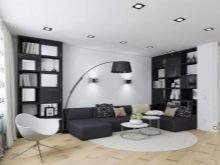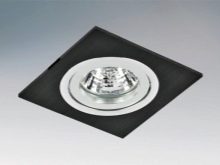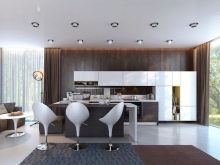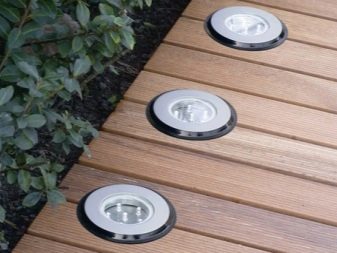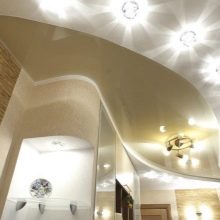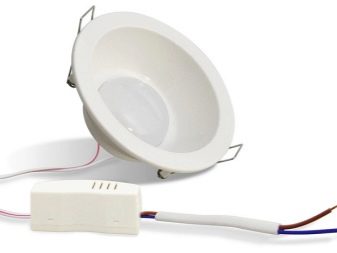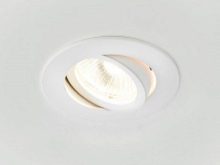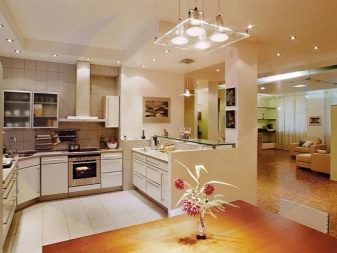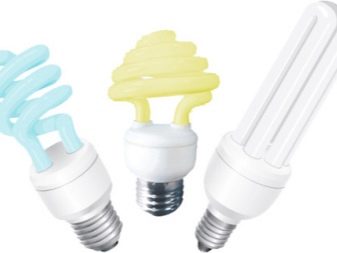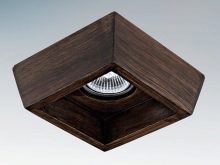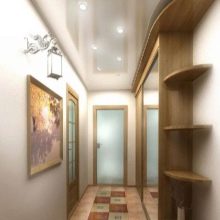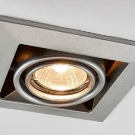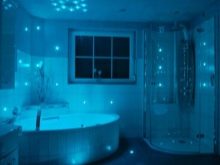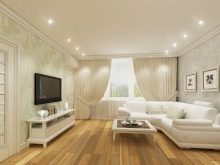Recessed lights

In recent years, the use of built-in lamps in the construction of houses, apartments and other premises is gaining popularity. Before buying embedded lighting devices, you should be familiar with their quality characteristics and manufacturers.
Specifications
A recessed luminaire is a lighting device, the body of which is partially hidden in the wall, ceiling or inside the furniture body. The quality properties of the selected luminaires depend on the purpose of use. It is important to understand the functions of the room in which these appliances will work.
Usually for uniform lighting fixtures are placed in a checkerboard pattern. The distance from the first light source to the wall should not exceed 60 cm, between lamps - up to 1.5 meters, between rows - 1 meter.
Power
It is important to observe the norms of specific power of lighting, which is calculated as the number of watts per square meter. optimal power parameters for different rooms:
- In the children's room - up to 60 W / m².
- Kitchen and dining room - up to 26 W / m².
- Living room, study - up to 22 W / m².
- Bathroom and toilet - up to 20 W / m².
- Bedroom - up to 15 W / m².
- Corridor, interior space, vestibules - up to 152 W / m².
Specialists emphasize that this indicator is typical for incandescent lamps. In the case of using LED devices, the power density is divided by 10, energy-saving devices - by 3.
Fittings
The modern market is filled with a variety of embedded lighting devices. In particular, they have different shapes and elements of decor, made of different materials.
Most street lamps are produced using metal, plastic protective parts and rubber or rubber seals. For bathrooms, saunas, baths or swimming pools it is better to use sealed appliances with protection against humidity.
The rest of the design depends on the ideas of the designer, since the models can be selected for any wallet: from glass, plastic, with crystals, from various metal alloys.
Kinds
By the nature of the luminous flux recessed lamps are classified into devices diffused and directional light. By functional features, you can select fixed or rotary. The latter really liked the designers as an additional lighting of individual objects or areas in the interior.
A large role among the characteristics of built-in lights plays the type of lamps. They can be halogen, LED, energy saving. Incandescent bulbs as recessed are completely unsuitable due to the strong heating of the housing. LED devices are especially popular. They are multifunctional. It is possible to use a double or triple diode in one case. In addition, an intensity control mechanism, dimming, was developed for them.
The shape of the lamps is divided into point, modular and linear. Dot lamp - this is the most common form, because it has the simplest design, simplicity to use and low cost. The design includes a housing with a built-in reflector, a braid and a light bulb.The body, in addition to the retaining, also performs decorative and protective functions.
Focal embedded devices experts call down the line. Among them, it is particularly possible to single out a dual point lamp, as well as models with an even greater number of light bulbs. They fit perfectly into the interior and make it more original.
If you use point devices as the main lighting, it is necessary to calculate the number required for a particular room. They are also used for additional lighting in conjunction with chandeliers and sconces. With the help of such lamps, you can stylistically select any part of the interior.
Panel lights are sometimes called raster. Modular light sources in the form of ceiling panels, as a rule, have standard dimensions of 60x60 cm. They most often use fluorescent lamps. Such models provide only the emission of directional light from the ceiling to the floor.
Most often, the profile lighting panels are used in offices, common areas, in production.
Linear fixtures are also called frameless. Basically, they consist of anodized aluminum profile and a diffuser of plastic. The width of the light panel varies from 25 to 50 mm.Embedded depth is small, which simplifies installation and allows you to expand the scope from decorative purposes to the main lighting.
The depth of the lamps are fully and partially embedded. The advantages of lamps, fully embedded in the wall, in the furniture, in the suspended ceiling, are indisputable. They create a safe and comfortable atmosphere in the room. However, in most cases, point variants are used only as a backlight, since for full coverage their number should be significant. It is necessary for comfort and coziness. For example, in the corridor or vestibule, the LEDs built into the plug-in will allow even family members with poor eyesight not to miss the mark.
Built-in lights allow you to embody any design ideas - from highlighting some details of the furniture to create a certain style of the entire room.
Panel models are always built in to the entire depth of the body, and due to the large area of the illuminating surface and the directional light, they perfectly cope with the function of the main lighting.
Among the luminaires that are partially built in, depending on the method of installation, they emit external or overhead, external (suspended) ones.The first experts are often used in cases where the base of the ceiling is solid, for example, concrete. The design is a fastener in the form of a platform, a housing with a lens and a lamp. Remote models are different from overhead and embedded in that the lamp hangs on the cable connecting the base and housing.
The energy-saving industry has been developing rapidly in recent years. In this regard, lamps appear on the market, equipped with additional functions, for example, with a dimmer or motion sensor.
Dimmable models have several advantages:
- Wide range of brightness changes.
- Brightness adjustment does not affect color reproduction.
- By reducing the brightness, you can increase the service life of the device.
- Inertness when adjusting is minimal.
Recessed lighting devices with motion sensors are popular in the entrances of apartment buildings, office corridors, warehouses, because they allow significant savings in electricity. The principle of operation is that the sensor scans the area and detects the presence of movement. When triggered, it transmits a signal to the built-in lamp, which lights up.In addition to the reaction to movement, such devices are equipped with sensors that monitor the level of illumination. This is necessary so that the lamp does not light up during the daytime.
Plaster fixtures for painting are just beginning to gain popularity. Their main advantage - the ability to paint in the colors of the desired shade, give texture. In addition, modern industry allows you to choose a variety of forms. The disadvantage, of course, is the fragility of the material itself, but this material is easy to restore.
Forms
Built-in models of lamps are divided according to the form.
The most common ones are:
- Semicircular with a large diffuser, covering a fairly large area. It is used for work on terraces, halls, street platforms.
- Oblong. In general, they are used for narrowly focused illumination of objects, for example, paintings.
- Cylindrical. More often have a swivel mount, therefore, able to change the direction of light. There are wall and floor options. Designers have them in rooms of unusual shape.
Lighting can be installed on surfaces made of plasterboard, chipboard and MDF panels, wood, plastic.
The housing of the built-in luminaire can have various forms, since it depends only on the designer's idea:
- Ring - the most common option.
- The square case is classically correct.
- Rectangular models can be from the smallest single downliners to large ceiling lighting panels.
- Linear lamps are usually long and thin.
- Ultrathin version of the case is possible only in LED devices.
Dimensions
When choosing a built-in lighting device, you must first take into account the criteria for the degree of convenience during further operation, in particular, the size of the lamp. To determine the diameter most often possible, taking into account the functional features of the room. For illumination it is enough to use products of the minimum sizes.
For overhead external luminaires, standard LED lamps are used, so their diameter is usually from 5 to 15 cm. For example, there are 4-5 such lamps in the bathroom. Sometimes you can find models of large sizes.
The sizes of standard models depend on the lamps used in them:
- The largest dimensions of the halogen lamps.Their diameter is from 11 cm, but it is approximate, since it is necessary to take into account the width of the base.
- Devices with incandescent bulbs should have a diameter of at least 8 cm.
- The smallest - LED devices, available from 5 to 7 cm.
In addition to the diameter, a significant parameter is the depth of landing. It is determined depending on the function of the lamp. For decorative purposes, usually use small lamps, in this case, the depth will be minimal.
The standard range focused on the type of lamps used is as follows:
- Depth from 1 cm is possible only for LEDs.
- Halogen lamps are built to a depth of 4 cm.
- The embedding depth for devices with incandescent lamps can vary from 20 to 30 cm.
For overhead or suspended built-in models, the height or length of the body is also important, which allows ergonomically fit the lighting fixtures into the surrounding interior space.
Lamps
Recessed lights use different types of lamps:
- Incandescent lamps. The most common and inexpensive option. The advantage is low cost, but it does not cover the disadvantages.Since these elements become very hot, they cannot be used for fully integrated appliances. In addition, the case of models with this type of lamp is usually the largest.
- Energy saving. Slightly better than the previous ones, but for embedded luminaires are their counterpart.
- Halogen. Options with low power inferior incandescent bulbs. With their help, when using reflective surfaces in construction, it is possible to obtain a fairly bright, narrowly focused light.
- LED (LED). The most popular option because of its versatility, minimum power consumption and low degree of heating. Luminaires with diodes can be very small, but no less bright. They allow you to get different color options. When used in the construction of various sensors, it is possible to control their characteristics.
Materials
Luminaire housing is made of a variety of materials. Among them:
- Plastic - The most common option because of its low cost and lightness. In addition, we can note a large color palette, a variety of textures and sizes, practicality.The disadvantage is burnout and the appearance of cracks.
- Metal - the second most popular material. Products from it look expensive, durable, resistant to various types of pollution, easy to maintain. However, the color scheme is restrained, the colors are mostly classical: gilding, silver or brass. Bronze decorative elements in the design of lamps are often found in the design of hotels and restaurants.
- Glass it is brittle, however it is wonderfully combined with any interiors, withstands negative external influences, has a wide range of colors. Crystal elements are typical for Provence style. However, crystal should be handled with care, so in rooms with young children it is better not to use them.
- Wood and ceramics - natural types of materials. They are appropriate for any interior, combined with any textures and are relatively inexpensive. Ceramic have one drawback - brittleness, so it must be handled with care. Wood cracks at low humidity and swells at high, so when installing the luminaire, this quality should be taken into account.
- Gypsum - gaining popularity recently material for manufacturing lighting fixtures. Recessed gypsum lighting is comfortable with its functionality. You can choose the desired shape, paint and give texture, if necessary, have the opportunity to restore it on their own.
The lens of light can be made either from plastic or from glass. Usually glass options are used in more expensive models. In any case, a mirror reflecting layer is required, which is applied to the inner surface.
Colors
There are many criteria for choosing the color range of external elements of the lamps. For some, invisibility is important, then the color should match the shade of the surface into which the device is embedded. If there is a need to highlight the lighting device as a separate element of the interior, the color, on the contrary, should be bright.
In the case of choosing a color as a psychological perception, the following can be noted:
- White stimulates performance.
- Black is sophisticated, but it can also introduce an element of emptiness.
- Green shades soothe.
- Blue colors can be depressing to some extent.
- Red tones increase the pressure.
- Blue contributes to its decrease.
Another important point when choosing lighting devices is the color temperature. Lamps can produce light white, yellow and blue hues. Warm eye usually defines as yellow, natural closer to white, and cold for us is seen as blue. Experts advise to choose a neutral option, one that is close to natural light.
How to place?
When installing the lighting system in the room, it is necessary to take into account the minimum gaps between the lamps and from them to the walls. When installing complex schemes for the location of embedded devices, specialists noticed that the optimal distance between spotlights and ceiling lights is 30 cm. The lighting devices are most efficiently positioned, retreating 20 cm from the wall. In the presence of a stretch ceiling, the gap between the lamp and the seam of the film must be at least 15 cm.
In case of non-standard surface decoration with a large number of downliners, for example, with the “starry sky” effect, their symmetrical arrangement should be arranged at equal distances.There are many ways to install fixtures, each one is unique and depends on the requirements of the style, the design idea and the owner’s wishes. In addition, an important role is played by the functional characteristics of the room.
Application options
With an ergonomic arrangement of built-in lighting devices in the interior, you can change the appearance of the room in terms of geometry. For example, if in a narrow corridor to arrange spotlights along the ceiling, the room will seem longer. The light falling on the ceiling from the eaves will increase the height of the ceiling in the living room. In the bathroom or in the hallway, you can set the backlight for the mirror, which will provide effective lighting of the face.
Downline built-in walls emphasize design ideas that create comfort and coziness in the room. Usually in this case, use LED devices. With their help illuminate the shelves, paintings or niches. The original solution is the lamps for lighting the stairs in private houses.
Recently, it has become popular to decorate built-in spots with terraces, loggias, garden arbors, winter gardens and greenhouses.
Rating of manufacturers and models
The most popular manufacturers of lighting products among buyers are Osram and Philips. These are reliable companies with extensive experience and a wide range of embedded lighting devices. Experts also highlight the products of the company Feron, since the cost of its products is slightly lower than the previous ones. This brand is characterized by high-quality lighting devices from ceiling to decorative.
Interesting models using LED lamps are manufactured by Gauss, ASD. Brands are somewhat inferior in terms of “promotion”, but their quality characteristics are excellent. Mention should be made of the brands Eglo, Arte Lamp, Novotech, since specialists are happy to use their products.
Styles
Among the options offered by manufacturers, it is impossible to choose the leaders, since buyers acquire both round washers, square, and icicles, triangular, spherical and other lamps.
Most often, the built-in lighting devices are selected in accordance with the style of the interior. If this is high-tech, then, as a rule, a chrome-plated metal case is used, which is “hidden” in the walls and ceiling, so that you can create a cosmic atmosphere in the living room or bathroom.
Classic downliners are characterized by options for lamps made of glass, plastic, plaster, sometimes with elements of stucco. They are designed to create in the interior a sense of wealth and respectability.
Point devices in the style of Provence use in their design various floral ornaments. The materials are suitable plastic, ceramics and glass of pastel colors. Often used metal cases of brass, bronze, nickel. Masters can artificially age them. Style implies moderation and romance, therefore sometimes at registration crystal pendants, candles, flowers are used.
How to choose?
Built-in lights can be selected by various parameters: function, color of light, size, shape, quantity. However, for a competent installation, an important criterion is the type of surface into which they will be mounted.
Installation of plasterboard ceilings will be the simplest of all available, since this type of material is susceptible to any deformation, cutting and leveling. With it, you can create various forms.
The main thing is to remember a few rules:
- Lamps should not fall into the joints of panel joints.
- The size of the hole drilled in drywall should be 4 millimeters larger than the diameter of the rail liner.
Among other things, drywall does not suffer much from the heating of the lamps, so you can use lamps with any type of lamps and different depths of embedding.
Concrete is the most inappropriate material for embedding lighting devices. However, this does not mean that this operation is impossible. Professionals, using a perforator, make holes, but warn that all work related to the deformation of the supporting structures should be coordinated by the housing state structures. Therefore, if you have a concrete ceiling, you should use other options. For example, you can lower it by 5-6 cm with the help of drywall, and the lighting will line up without problems. Designers offer options and eaves placement of lamps.
It often happens that the repair in the apartment has already been made, and the idea of changing the lighting came later. If the walls are decorated with textured plaster, then embedded plaster models are the most suitable option. They will organically fit into the interior, without focusing on the device itself.When installing the seams and holes from the mount, as well as the luminaire body plaster in the style of the walls or ceiling. Subsequently, the coating can be painted.
PVC film as a material for decorating the ceiling is very popular. However, not all types of lamps are suitable for it. For example, incandescent bulbs are contraindicated for this type of material.
The choice of fixtures for fixtures are selected individually depending on the design.
Professionals identify three basic rules for installation:
- Devices must be attached to the ceiling, and not to the ceiling itself, since it is deformed by the weight of the lighting devices.
- Height adjustment is made using the mounting ring.
- The dimensions of the hole into which the device will be embedded must be larger than the luminaire itself.
Another important quality - for a stretch ceiling can not choose a flat chandelier. Often the base of such devices is made of metal alloys, which are susceptible to heat, which threatens to spoil the material of the ceiling fabric. LED and fluorescent lamps are best for such designs.
Floor lamps are unusual, so they liked the designers.With their help, you can customize various special effects. The scope is wide: architectural designs, garden paths, pools, park avenues, podiums.
Popular types:
- Mortise similar to fully embedded.
- Dome - over their surface enters the ceiling.
Outdoor street lamps should have the following qualities:
- Moisture resistance of connections and housing.
- Impact protection.
- Scattered light.
In the interior, recessed lights are often used as additional lighting. In particular, wardrobe lighting, kitchen and corridor lighting structures have a particular popularity. To create coziness and comfort they are mounted in wall panels, ceiling cornices, niches and shelves.
To enhance the contrast and visual illusions in dark rooms set narrowly focused linear devices of different lengths. In the cottages and private houses, lamps are mounted on the wall in the house, next to which there are no windows, which allows to increase the illuminated area.
How to install recessed lights in the ceiling with your own hands, see this video.



